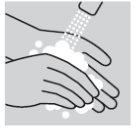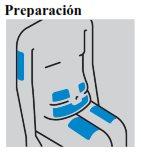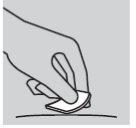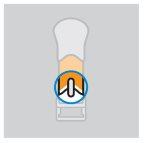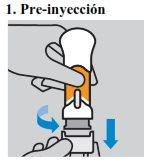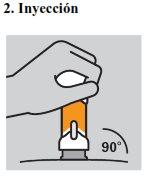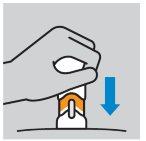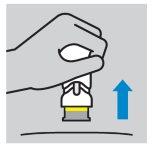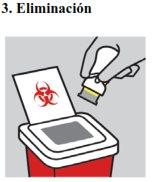
How to use PELGRAZ 6 mg PRE-FILLED INJECTABLE SOLUTION
Introduction
Package Leaflet: Information for the User
Pelgraz 6 mg solution for injection in pre-filled syringe
pegfilgrastim
Read all of this leaflet carefully before you start using this medicine because it contains important information for you.
- Keep this leaflet, you may need to read it again.
- If you have any further questions, ask your doctor, pharmacist or nurse.
- This medicine has been prescribed for you only. Do not pass it on to others. It may harm them, even if their signs of illness are the same as yours.
- If you get any side effects, talk to your doctor, pharmacist or nurse. This includes any possible side effects not listed in this leaflet. See section 4.
Contents of the pack and other information
- What is Pelgraz and what is it used for
- What you need to know before you use Pelgraz
- How to use Pelgraz
- Possible side effects
- Storing Pelgraz
- Contents of the pack and other information
1. What is Pelgraz and what is it used for
Pelgraz contains the active substance pegfilgrastim. Pegfilgrastim is a protein produced by biotechnology in the bacterium E. coli. Pegfilgrastim belongs to a group of proteins called cytokines and is very similar to a natural protein (granulocyte colony-stimulating factor) produced by our body.
Pelgraz is used to reduce the duration of neutropenia (low white blood cell count) and the incidence of febrile neutropenia (low white blood cell count and fever) that may occur as a result of cytotoxic chemotherapy (medicines that destroy rapidly dividing cells). White blood cells are important cells that help fight infections. These cells are sensitive to the effects of chemotherapy, which can cause their numbers to decrease. If the number of white blood cells becomes too low, there may not be enough to fight off bacteria, which can lead to a higher risk of infection.
Your doctor has prescribed Pelgraz to stimulate your bone marrow (the part of the bone where blood cells are produced) to produce more white blood cells to help you fight infections.
2. What you need to know before you use Pelgraz
Do not use Pelgraz
- if you are allergic to pegfilgrastim, filgrastim, or any of the other ingredients of this medicine (listed in section 6).
Warnings and precautions
Tell your doctor, pharmacist or nurse before using Pelgraz if:
- you experience an allergic reaction that includes weakness, decreased blood pressure, difficulty breathing, swelling of the face (anaphylaxis), redness and flushing, skin rash and itching.
- you have a latex allergy. The needle cap of the pre-filled syringe contains a latex derivative that may cause severe allergic reactions.
- you experience cough, fever and difficulty breathing. This may be a sign of Acute Respiratory Distress Syndrome (ARDS).
- you experience any or a combination of the following side effects:
- swelling that may be associated with urinating less frequently, difficulty breathing, swelling and feeling of abdominal fullness and a general feeling of tiredness.
These may be symptoms of a disease called "Capillary Leak Syndrome" and may cause blood to leak from a small blood vessel into other parts of your body. See section 4.
- if you have pain in the upper left abdomen or pain in the tip of the shoulder. This may be a sign of a problem with the spleen (splenomegaly).
- you have recently had a severe lung infection (pneumonia), fluid in the lungs (pulmonary edema), inflammation of the lungs (interstitial lung disease) or an abnormal chest X-ray result (pulmonary infiltration).
- you are aware of any alteration in blood cell count (e.g. increased white blood cell count or anemia) or a decrease in blood platelet count, which may reduce the ability of the blood to clot (thrombocytopenia). Your doctor may want to monitor you more closely.
- you have sickle cell anemia. Your doctor may monitor your disease more closely.
- if you are a cancer patient, the combined treatment of Pelgraz with chemotherapy and/or radiotherapy may increase the risk of developing a pre-cancerous hematological disease called myelodysplastic syndrome (MDS) or a hematological malignancy called acute myeloid leukemia (AML). Symptoms may include fatigue, fever, easy bruising or bleeding.
- you have sudden signs of allergy, such as rash, itching or hives on the skin, swelling of the face, lips, tongue or other parts of the body, shortness of breath, wheezing or difficulty breathing, may be signs of a severe allergic reaction.
- symptoms of inflammation of the aorta (the large blood vessel that carries blood from the heart to the body), this has rarely been reported in cancer patients and healthy donors. Symptoms may include fever, abdominal pain, general malaise, back pain and elevated inflammatory markers (e.g. C-reactive protein and white blood cell count). Tell your doctor if you experience these symptoms.
Your doctor will perform regular blood and urine tests as Pelgraz may damage the small filters within the kidneys (glomerulonephritis).
Severe skin reactions (Stevens-Johnson syndrome) have been reported with the use of Pelgraz. Stop using Pelgraz and seek medical attention immediately if you notice any of the symptoms described in section 4.
You should discuss with your doctor the risk of developing blood cancer. If you develop or may develop blood cancer, you should not use Pelgraz, unless your doctor advises you to.
Loss of response to pegfilgrastim
If you experience a loss of response or if you do not achieve a response to treatment with pegfilgrastim, your doctor will investigate the causes, including whether you have developed antibodies that may neutralize the activity of pegfilgrastim.
Children and adolescents
The safety and efficacy of Pelgraz in children and adolescents have not been established. Consult your doctor or pharmacist before taking any medicine.
Other medicines and Pelgraz
Tell your doctor or pharmacist if you are using, have recently used or might use any other medicines.
Pregnancy and breastfeeding
Consult your doctor or pharmacist before using any medicine. Pelgraz has not been used in pregnant women. It is important that you inform your doctor if:
- you are pregnant;
- you think you may be pregnant; or
- you plan to become pregnant.
If you become pregnant during treatment with Pelgraz, please inform your doctor.
Unless your doctor advises you otherwise, you should stop breastfeeding if you use Pelgraz.
Driving and using machines
Pelgraz has no or negligible influence on the ability to drive and use machines.
Pelgraz contains sorbitol (E420) and sodium
This medicine contains 30 mg of sorbitol in the pre-filled syringe, equivalent to 50 mg/ml.
This medicine contains less than 1 mmol of sodium (23 mg) per 6 mg dose; this is essentially "sodium-free".
3. How to use Pelgraz
Pelgraz is indicated in patients over 18 years of age.
Follow the instructions for administration of Pelgraz exactly as prescribed by your doctor. Consult your doctor or pharmacist if you have any doubts. The usual dose is a single subcutaneous injection of 6 mg (under the skin), with a pre-filled syringe, which should be administered at the end of each chemotherapy cycle, at least 24 hours after your last dose of chemotherapy.
Do not shake Pelgraz vigorously as this may affect its activity.
Self-injection of Pelgraz
Your doctor may consider it more convenient for you to inject Pelgraz yourself. Your doctor or nurse will teach you how to do this. Do not attempt to do this unless you have received special training from your doctor or nurse.
The instructions for self-injection of Pelgraz are below, but the correct treatment of your disease requires close and constant cooperation with your doctor.
If you are unsure about how to administer the injection or have any doubts, ask your doctor or nurse for help.
How do I give myself a Pelgraz injection?
You will need to inject it into the tissue under the skin. This is called a subcutaneous injection
Equipment you need
To give yourself a subcutaneous injection, you will need:
- a pre-filled Pelgraz syringe;
- alcohol swab.
What should I do before giving myself a subcutaneous injection of Pelgraz?
- Take the pre-filled syringe out of the refrigerator.
- Check the expiry date on the label of the pre-filled syringe (EXP). Do not use it if it has passed the last day of the month stated or if it has been out of the refrigerator for more than 15 days or is expired.
- Check the appearance of Pelgraz. It should be a clear and colorless liquid. Do not use it if there are particles
- To make the injection more comfortable, let the pre-filled syringe sit at room temperature for 30 minutes or hold the pre-filled syringe gently in your hand for a few minutes. Do not heat Pelgraz in any other way (e.g. do not heat it in the microwave or in hot water).
- Wash your hands carefully.
- Find a comfortable, well-lit place and put everything you need within reach (the pre-filled syringe and the alcohol swab).
How do I prepare my Pelgraz injection?
Before injecting Pelgraz, you must do the following:
- Choose a clean, well-lit area to administer the medicine.
- Check the expiry date on the packaging. Do not use it if it has passed the expiry date.
- Gather an alcohol swab and a sharps container
|
|
|
|
|
|
|
|
|
|
|
|
|
|
|
|
|
|
|
|
Remember
If you have any problems, ask your doctor or nurse for help and information.
If you use more Pelgraz than you should
If you use more Pelgraz than you should, contact your doctor, pharmacist or nurse.
If you forget to use Pelgraz
If you are self-injecting and have forgotten to administer your dose of Pelgraz, contact your doctor to decide when you should inject the next dose.
If you stop using Pelgraz
Your doctor will tell you when to stop using Pelgraz. It is quite normal to have a series of treatment cycles with Pelgraz.
If you have any other questions about the use of this medicine, ask your doctor or pharmacist.
4. Possible Adverse Effects
Like all medicines, this medicine can cause adverse effects, although not all people suffer from them.
Immediately inform your doctor if you experience any or a combination of the following adverse effects:
- Swelling that may be associated with urinating less frequently, difficulty breathing, swelling, and a feeling of abdominal fullness and a general feeling of tiredness. These symptoms usually develop very quickly.
These may be symptoms of a disease that occurs infrequently (which can affect up to 1 in 100 people) called "capillary leak syndrome" and may cause blood to leak from a small blood vessel to other parts of your body and require urgent medical attention.
Very Common Adverse Effects(may affect more than 1 in 10 patients):
- Bone pain. Your doctor will inform you about what you can take to calm the pain.
- Nausea and headache.
Common Adverse Effects(may affect up to 1 in 10 patients):
- Pain at the injection site.
- General pain and pain in the joints and muscles.
- Chest pain not caused by heart disease or heart attack.
- Some changes may occur in your blood, which will be detected through periodic blood tests. The number of white blood cells may increase for a short period. The number of platelets may decrease, which can cause bruising.
Uncommon Adverse Effects(may affect up to 1 in 100 patients):
- Allergic reactions, including redness and flushing, rash, and skin inflammation with itching.
- Severe allergic reactions, including anaphylaxis (weakness, drop in blood pressure, difficulty breathing, facial swelling).
- Increased spleen size.
- Spleen rupture. Some cases of spleen rupture were fatal. It is essential that you contact your doctor immediately if you notice pain in the upper left part of your abdomen or in the left shoulder, as they may be related to a problem with your spleen.
- Respiratory problems. If you have a cough, fever, and difficulty breathing, consult your doctor.
- Cases of Sweet's syndrome (painful, inflamed, purple-colored lesions on the extremities and sometimes on the face and neck, accompanied by fever) have occurred, but may be related to other factors.
- Cutaneous vasculitis (inflammation of the skin blood vessels).
- Damage to the small filters inside the kidneys (glomerulonefritis).
- Redness at the injection site.
- Abnormal blood test results (lactate dehydrogenase, uric acid, and alkaline phosphatase).
- Abnormal blood test results related to the liver (alanine aminotransferase, aspartate aminotransferase).
- Blood-tinged cough (hemoptysis).
- Hematological disorders (myelodysplastic syndrome [MDS] or acute myeloid leukemia [AML]).
Rare Adverse Effects(may affect 1 in 1,000 people):
- Inflammation of the aorta (the large blood vessel that carries blood from the heart to the body) see section 2.
- Bleeding from the lung (pulmonary hemorrhage)
- Stevens-Johnson syndrome, which can appear as reddish spots with a target-like or circular appearance, often with central blisters on the trunk, skin peeling, ulcers in the mouth, throat, nose, genitals, and eyes, and may be preceded by fever and flu-like symptoms. Stop using Pelgraz if you develop these symptoms and contact your doctor or seek immediate medical attention. See also section 2.
Reporting Adverse Effects
If you experience any type of adverse effect, consult your doctor, pharmacist, or nurse, even if it is a possible adverse effect that is not listed in this prospectus. You can also report them directly through the national reporting system included in Appendix V. By reporting adverse effects, you can contribute to providing more information on the safety of this medicine.
5. Storage of Pelgraz
Keep this medicine out of the sight and reach of children.
Do not use this medicine after the expiration date that appears on the box and on the label of the syringe after CAD. The expiration date is the last day of the month indicated.
Store in the refrigerator (between 2°C and 8°C).
Pelgraz can be at room temperature (not above 25°C ± 2°C) for a single period of up to 15 days. If Pelgraz is left at room temperature for more than 15 days, it should be discarded. For any doubts about storage, ask your doctor, nurse, or pharmacist.
Do not freeze. Accidental exposure to freezing temperatures for a single period of less than 24 hours does not negatively affect the stability of Pelgraz.
Keep the pre-filled syringe in the box to protect it from light.
Do not use this medicine if you observe that the solution is not completely transparent or contains particles.
Medicines should not be thrown away through wastewater or household waste. Ask your pharmacist how to dispose of the packaging and medicines that you no longer need. This will help protect the environment.
6. Package Contents and Additional Information
- The active ingredient is pegfilgrastim. Each pre-filled injector contains 6 mg of pegfilgrastim in 0.6 ml of solution.
- The other components are sodium acetate, sorbitol (E420), polysorbate 20, and water for injectable preparations. (See section 2).
Appearance of the Product and Package Contents
Pelgraz is a clear, colorless injectable solution in a pre-filled injector with an injection needle. Each pre-filled injector contains 0.6 mg of solution.
Pelgraz is available in a package with 1 pre-filled injector, in an individual box, and a cotton swab with alcohol.
Marketing Authorization Holder and Manufacturer
Marketing Authorization Holder
Accord Healthcare S.L.U.
World Trade Center, Moll de Barcelona, s/n,
Edifici Est 6ª planta,
08039 Barcelona,
Spain
Manufacturer
Accord Healthcare Polska Sp.z o.o.,
ul. Lutomierska 50,95-200 Pabianice, Poland
Accord Healthcare B.V.,
Winthontlaan 200,
3526 KV Utrecht,
Netherlands
You can request more information about this medicine by contacting the local representative of the marketing authorization holder.
AT / BE / BG / CY / CZ / DE / DK / EE / FI / FR / HR / HU / IS / LT / LV / LX/ MT / NL / NO /PT / PL / RO / SE / SI / SK / ES
Accord Healthcare S.L.U. Tel: +34 93 301 00 64
IT
Accord Healthcare Italia
Tel: +39 02 94323700
EL
Win Medica Pharmaceutical S.A.
Tel: +30 210 7488 821
Date of the Last Revision of this Prospectus: 06/2023
Detailed information about this medicine is available on the European Medicines Agency website http://www.ema.europa.eu/.
This information is intended only for doctors or healthcare professionals:
Pelgraz does not contain any preservative. In view of the possible risk of microbial contamination, the pre-filled injectors Pelgraz are for single use.
Do not freeze. Accidental exposure to freezing temperatures for up to 24 hours does not affect the stability of Pelgraz. If the exposure has been more than 24 hours or has been frozen more than once, DO NOT use Pelgraz.
To improve the traceability of granulocyte colony-stimulating factors, the name of the medicine (Pelgraz) and the batch number of the pre-filled injector administered should be clearly recorded in the patient's file.
Elimination
The elimination of unused medicine and all materials that have come into contact with it will be carried out in accordance with local regulations.
- Country of registration
- Active substance
- Prescription requiredYes
- Manufacturer
- This information is for reference only and does not constitute medical advice. Always consult a licensed doctor before taking any medication. Oladoctor is not responsible for medical decisions based on this content.
- Alternatives to PELGRAZ 6 mg PRE-FILLED INJECTABLE SOLUTIONDosage form: INJECTABLE, 6 mgActive substance: pegfilgrastimManufacturer: Biosimilar Collaborations Ireland LimitedPrescription requiredDosage form: INJECTABLE, 6 mg of pegfilgrastim (10mg/ml)Active substance: pegfilgrastimManufacturer: Amgen Europe B.V.Prescription requiredDosage form: INJECTABLE, 6 mgActive substance: pegfilgrastimManufacturer: Amgen Europe B.V.Prescription required
Alternatives to PELGRAZ 6 mg PRE-FILLED INJECTABLE SOLUTION in other countries
The best alternatives with the same active ingredient and therapeutic effect.
Alternative to PELGRAZ 6 mg PRE-FILLED INJECTABLE SOLUTION in Ukraine
Online doctors for PELGRAZ 6 mg PRE-FILLED INJECTABLE SOLUTION
Discuss dosage, side effects, interactions, contraindications, and prescription renewal for PELGRAZ 6 mg PRE-FILLED INJECTABLE SOLUTION – subject to medical assessment and local rules.





